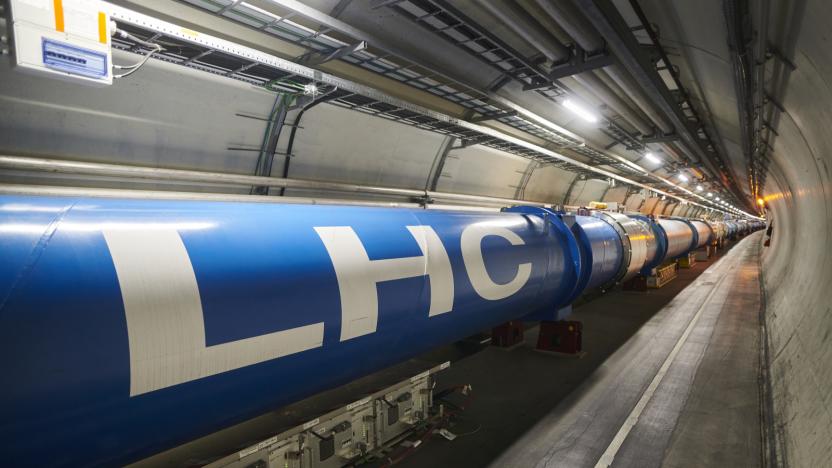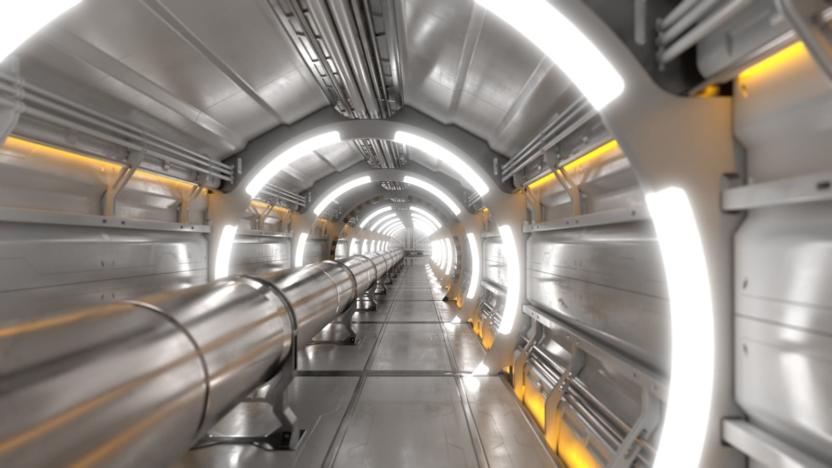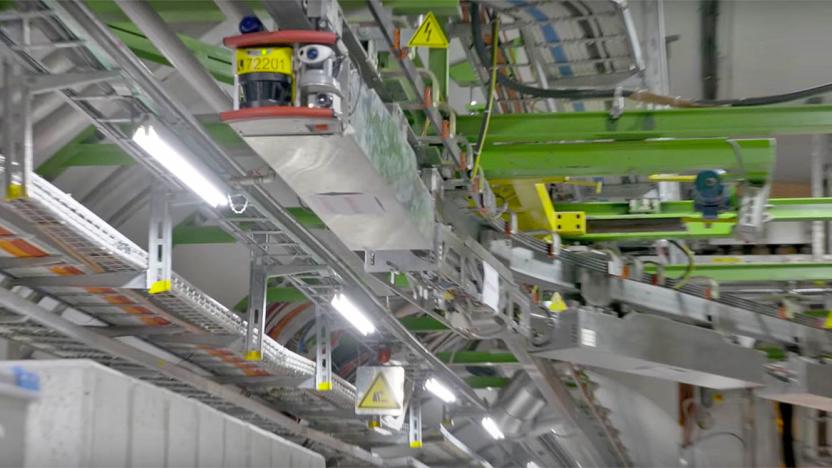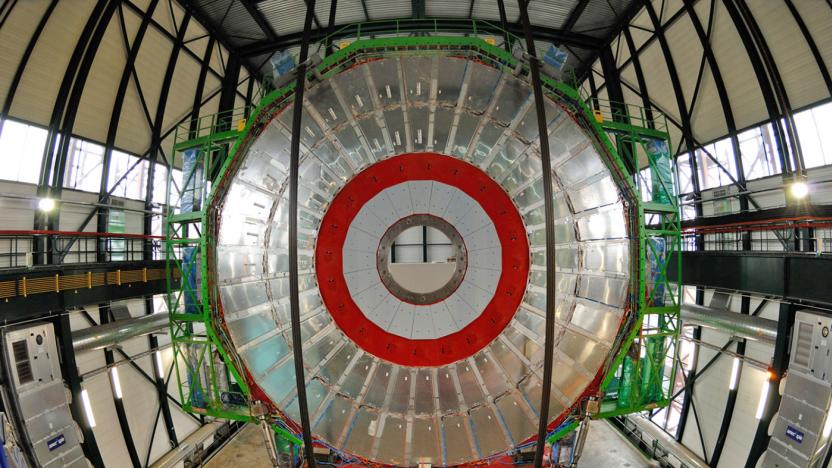LHC
Latest

The Large Hadron Collider is smashing protons again after a three-year hiatus
It was shut down for maintenance and upgrades, so it can deliver more data.

CERN plans to build a collider four times bigger than the LHC
Back in 2014, CERN sought the help of over 1,300 contributors to help it conjure up a feasible plan for a new collider much, much bigger than the LHC. Now, the research organization has unveiled preliminary designs for the project named Future Circular Collider (FCC). Based on current plans, it will make the LHC (Large Hadron Collider) look tiny in comparison: the designs are calling for a massive particle accelerator 100 kilometers or 62 miles around. The LHC is only 27 kilometers or 17 miles long. It will also be up to six times more powerful than the smaller accelerator.

CERN introduces Large Hadron Collider's robotic inspectors
Since the Large Hadron Collider (LHC) needs to be in tip-top shape to discover new particles, it has two inspectors making sure everything's in working order. The two of them are called TIM, short not for Timothy, but for Train Inspection Monorail. These mini autonomous monorails that keep an eye on the world's largest particle collider follow a pre-defined route and get around using tracks suspended from the ceiling. According to CERN's post introducing the machines, the tracks are remnants from the time the tunnel housed the Large Electron Positron instead of the LHC. The LEP's monorail was bigger, but not quite as high-tech: it was mainly used to transport materials and workers.

Large Hadron Collider's new 'particle' was just a fluke
Sorry, folks: CERN didn't mean to get your hopes up. Researchers have determined that Large Hadron Collider data suggesting a possible new particle was really just a "statistical fluctuation." Additional data collected over the course of the past several months reduced the unusual diphoton "bump" to a significance of 2 sigma, or well below the 5 sigma needed for a discovery to be considered authentic. It's just unusual that scientists saw a blip like this at both the ATLAS and CMS experiments, ATLAS' Dave Charlton explains to Scientific American.

Make music with the Large Hadron Collider through a web app
Now that music has come to the Large Hadron Collider, it's time for the giant science ring to make some music of its own. Meet Quantizer, a project from students Juliana Cherston and Ewan Hill that turns the ATLAS experiment's many, many particle collisions into music. The web app grabs data (in real-time when possible), cleans it up and maps it to musical notes. After that, it's just a question of the style you want to hear. There are cosmic sounds if you prefer an ambient vibe, or house music if you'd like something a little more dance-worthy.

Tech doesn't work with children and animals
It's a tale as old as time: Kids and animals don't mix with tech. Whether it's little Billy turning your new flatscreen on and off until it burns out or Rover chewing through another pair of fancy headphones, you'd think we'd know better by now that letting pretty much anything that isn't capable of voting near technology is a bad idea. But as you're about to find out, sometimes it just can't be helped.

CERN opens access to 300TB of Large Hadron Collider data
CERN will keep you researchers, students and dataphiles busy this weekend. The institute has released 300 terabytes of Large Hadron Collider data collected by the Compact Muon Solenoid (CMS) detector back in 2011. You know how scientists use the collider to smash particles? Well, the CMS is one of the two components of the LHC with the capability to see the particles (like the Higgs boson) or phenomena produced by those high-energy collisions.

ICYMI: Sad unicorn truth, disease-fighting drones and more
#fivemin-widget-blogsmith-image-781614{display:none;} .cke_show_borders #fivemin-widget-blogsmith-image-781614, #postcontentcontainer #fivemin-widget-blogsmith-image-781614{width:570px;display:block;} try{document.getElementById("fivemin-widget-blogsmith-image-781614").style.display="none";}catch(e){}Today on In Case You Missed It: The news that a type of unicorn walked the earth at the same time as prehistoric humans makes modern-day fantasy novels make a lot more sense. CERN is getting its Large Hadron Collider back online after a hiatus to improve its electrical system. And Ethiopia is using drones to drop sterile tsetse flies over the country, intending for them to breed with the wild natives and cut back on the population of disease-carrying insects, thus lowering risk of illness to humans and animals. We also share that paleontologists mapped the evolution of the largest type of dinosaurs, learning new things about them; and also touched on how vertical farming operations are moving into grocery stores. As always, please share any great tech or science videos you find by using the #ICYMI hashtag on Twitter for @mskerryd.

The After Math: These numbers are 'yuge'
The GOP holding a debate without the overcooked sweetpotato that is Donald Trump wasn't even the week's biggest news. We found the world's biggest solar system, US Customs confiscated an enormous number of knockoff hoverboards and CERN began rewiring the LHC for added atom-smashy fun, to name a few.

Large Hadron Collider may have detected a new particle
The rejuvenated Large Hadron Collider might have achieved another breakthrough... provided everything lines up, that is. Two teams of CERN scientists have detected an excess of gamma ray pairs that they suspect might represent the radioactive decay of a previously unknown particle. The data is far from conclusive (there's a 1 in 93 chance that it's nothing), and the researchers don't expect to have enough data until they present at a convention next summer. However, it's rare that two groups notice the same anomaly -- that's frequently a sign that something's up.

The Large Hadron Collider's next upgrade is moving forward
The Large Hadron Collider recently got back to work after a two-year layoff for maintenance and upgrades, but soon it will go under the knife again. Last week 230 scientists met at CERN in Switzerland to discuss the High-Luminosity LHC (HL-LHC) project, and move it from the development phase to the construction stage. After two more Long Shutdown periods in 2019 and 2024, the HL-LHC will deliver 10 times the amount of particle collisions it does now. New technology coming its way includes 12 superconducting quadropole magnets (one is pictured above), "crab" cavities that tilt the particle beams before collisions and more. When we took a look at the science behind particle accelerators a few years ago, the HL-LHC was already in development and after a four year design study it's one (big) step closer to reality.

Large Hadron Collider gets back to running science experiments
What's that strange circular shape, you ask? That, friends, is what particle physics looks like when it's getting back on track. After weeks of test runs following its return to service, the Large Hadron Collider has resumed smashing particles together for the sake of real, honest-to-goodness science experiments -- those criss-crossing lines in the image above are a few of the early collisions. And this time, there's much more energy involved. The LHC is now colliding particles at a level of 13 trillion electron volts, or nearly twice as much energy as it used before its two-year downtime. The boost will hopefully lead to physics discoveries that weren't possible in the previous go-round, which is saying something when some past results were enough to earn a Nobel prize. [Image credit: CERN]

The Large Hadron Collider is back and stronger than ever
Yes, it's back -- after a two-year upgrade program, CERN's Large Hadron Collider is once again operational. Scientists are only firing collision-free proton beams right now to test the new system, but they'll ramp up over the next few months to the point where they're smashing protons together at 13 teraelectronvolts -- about twice the energy the LHC managed in its first season. The machine will have a relatively short three years to operate before its next shutdown, but the higher output should help researchers explore antimatter, dark matter and other aspects of physics that are relatively untested. Given that the collider appears to have discovered the mysterious Higgs boson during its first run, we're hopeful that its second season has more breakthroughs in store. [Image credit: CERN]

Higgs boson researchers awarded Nobel Prize for physics
Sure, it may have been one of the easier Nobel prizes to call in recent years -- at least partly -- but that doesn't make it any less notable. This morning, the Royal Swedish Academy of Sciences awarded the Nobel Prize in Physics to Peter Higgs and Francois Englert "for the theoretical discovery of a mechanism that contributes to our understanding of the origin of mass of subatomic particles," or what's come to be known as the Higgs boson. While the prize doesn't extend to the researchers at CERN who confirmed the existence of the Higgs particle last year, the Nobel committee did cite their work in the announcement, as did Peter Higgs himself, who said in a prepared statement that he "would also like to congratulate all those who have contributed to the discovery of this new particle." Professor Higgs isn't offering any more than that statement today, though -- one of his Edinburgh University colleagues tells the BBC that "he's gone on holiday without a phone."

Google Street View lets you stroll around CERN, no doctorate required
Previously, free rein to explore the labyrinthine laboratory that is CERN has been granted only to the lucky, or those with four degrees and an aptitude for finding theoretical particles. That changes today, however, as anyone can now explore the home of the Large Hadron Collider in Geneva, Switzerland through Google Street View. All the imagery was captured back in 2011, but it's finally been stitched together, allowing you to wander freely around the site of the famous particle accelerator and learn a little about its experiments. Hit up Google Views to begin your personal guided tour, and let us know if you spot this Higgs fellow everyone's so keen on finding.

Primed: The smashing science behind particle accelerators
Primed goes in-depth on the technobabble you hear on Engadget every day -- we dig deep into each topic's history and how it benefits our lives. You can follow the series here. Looking to suggest a piece of technology for us to break down? Drop us a line at primed *at* engadget *dawt* com. Long before the Large Hadron Collider (LHC) could smash its first atoms, researchers manning the Tevatron collider at Fermilab, in a quiet suburb 40 miles west of Chicago, raced to find evidence that the Higgs boson exists. After roughly three decades of service, the Tevatron shut down for good in late 2011, dealing the city of Batavia's largest employer a significant blow. Less than 18 months later, the LHC (the Tevatron's technological successor) also went offline - albeit temporarily. Only four years after recording its first proton collisions, the team at CERN is already scrambling to upgrade the staggering LHC, which lies under parts of no less than five cities in both France and Switzerland. With the world's largest particle colliders smashing a whole lot of nothing together for the next two years at least, the field of high-energy physics research is starting to look resource-starved. Of course, many might ask why exactly we need giant atom smashers like this, or even how they work. It turns out that first part is quite a bit easier to answer than the second. During the last several decades, particle accelerators have revealed the existence of elementary particles such as quarks, led to the discovery of antimatter and generally helped us unlock the mysteries of the universe. And once they were done splitting atoms and probing the darkest corners of theoretical physics, accelerators often led to breakthroughs in medical imaging and cancer research. So, as massive colliders seem ready to land on the endangered species list, it seems as good a time as any to explain what a particle collider is, how it works and what we as a society have to gain from the research.

Into the heart of CERN: an underground tour of the Large Hadron Collider (video)
"Why, sometimes I've believed as many as six impossible things before breakfast." ― Lewis Carroll, Alice in Wonderland I've been to see ALICE -- though there was no looking glass to jump through, just a retina scanner and one very long elevator ride down into the earth. I've toured a CMS that has nothing to do with online publishing. I've even gently laid my body on the most powerful particle accelerator in the world and raised the ire of surrounding engineers in the interest of a good shot. I did all of this at CERN, the international particle physics laboratory located near Geneva, Switzerland. But you probably know it best as the birthplace of the world wide web and home of the Large Hadron Collider. And, yes, it was all exactly like a walking fever dream. %Gallery-192868% %Gallery-192867% %Gallery-192869% %Gallery-192870%

Visualized: this is where the Higgs Boson was discovered
It's not everyday you get to tour CERN, the international particle physics research facility that spans the border of both France and Switzerland. It's even more rare to go down into the sprawling facility's tunnels to see an inactive and under repair Large Hadron Collider -- currently, the world's most powerful particle accelerator. But that's just what we did this past week, as we spent some quality time with CERN's physicists and visited the dormant LHC, as well as two of its detectors: ALICE and CMS (pictured above). There'll be much more to come from our trip to CERN, so stay tuned. But for now feast your eyes on the birthplace of the Higgs Boson discovery.

Large Hadron Collider stops for two years of tune-ups, goes out on a high note (video)
We've long known that the Large Hadron Collider would need to take a break, but that doesn't take the edge off of the moment itself: as of Valentine's Day, the particle accelerator has conducted its last test for the next two years. The giant research ring will undergo sweeping repairs and upgrades that should should give it the superconducting connectors needed to hit the originally planned 14TeV of combined collision energy, versus the 8TeV it's been limited to almost since the beginning. CERN's machine arguably earned the downtime. After a rough start, it went on to produce rafts of collision data and healthy evidence of the elusive Higgs boson. If you're still down, think of the hiatus as doing us a favor -- it postpones any world-ending disasters until around 2015.

Large Hadron Collider may have produced a previously undetected form of matter
Teams at the Large Hadron Collider must be developing a knack for producing tangible evidence of theoretical particles. After orchestrating 2 million collisions between lead nuclei and protons, like the sort you see above, the collider's Compact Muon Solenoid group and researchers at MIT suspect that stray, linked pairs of gluon particles in the mix were signs of color-glass condensate, a currently theory-only form of matter that sees gluons travel in liquid-like, quantum-entangled waves. The clues aren't definitive, but they were also caught unexpectedly as part of a more routine collision run; the team is curious enough that it's looking for more evidence during weeks of similar tests in January. Any conclusive proof of the condensate would have an impact both on how we understand particle production in collisions as well as the ways gluons and quarks are arranged inside protons. If so, the CMS and MIT teams may well answer a raft of questions about subatomic physics while further justifying CERN's giant underground rings.









